Abstract
A new method has been described for measuring the pressure and resistance to blood flow in the pulmonary arteries, capillaries, and veins. Studies were performed in dog isolated lung lobes perfused at constant flow with blood from a donor dog. Pulmonary artery and vein volume and total lobar blood volume were measured by the ether plethysmograph and dyedilution techniques. The longitudinal distribution of vascular resistance was determined by analyzing the decrease in perfusion pressure caused by a bolus of low viscosity liquid introduced into the vascular inflow of the lobe.
The pulmonary arteries were responsible for 46% of total lobar vascular resistance, whereas the pulmonary capillaries and veins accounted for 34 and 20% of total lobar vascular resistance respectively. Vascular resistance was 322 dynes ·sec·cm-5/ml of vessel in the lobar pulmonary arteries, 112 dynes·sec·cm-5/ml in the pulmonary capillaries, and 115 dynes·sec·cm-5/ml in the lobar pulmonary veins. Peak vascular resistivity (resistance per milliliter of volume) was in an area 2 ml proximal to the capillary bed, but resistivity was high throughout the pulmonary arterial tree. The pulmonary arteries accounted for approximately 50% of vascular resistance upstream from the sluice point when alveolar pressure exceeded venous pressure.
The method described provides the first measurements of pulmonary capillary pressure. Mid-capillary pressure averaged 13.3 cm H2O, pulmonary artery pressure averaged 20.4 cm H2O, and pulmonary vein pressure averaged 9.2 cm H2O. These techniques also provide a way of analyzing arterial, capillary, and venous responses to various pharmacologic and physiologic stimuli.
Full text
PDF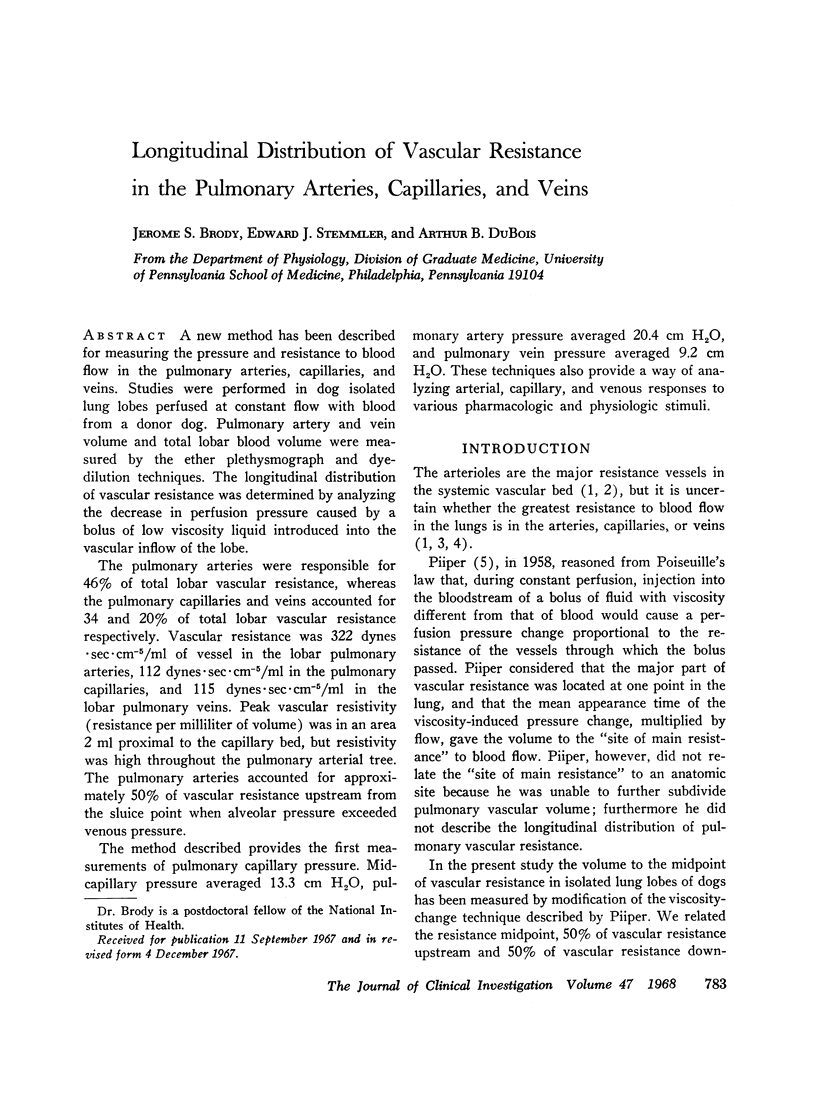
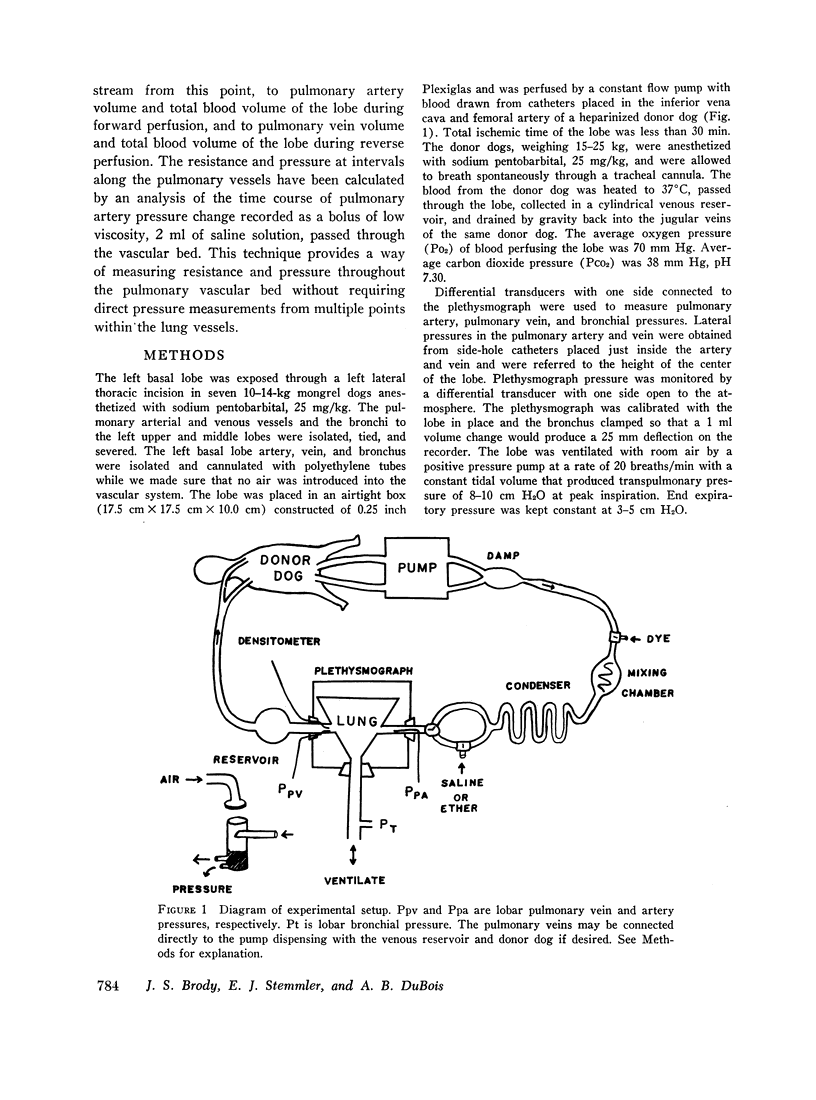
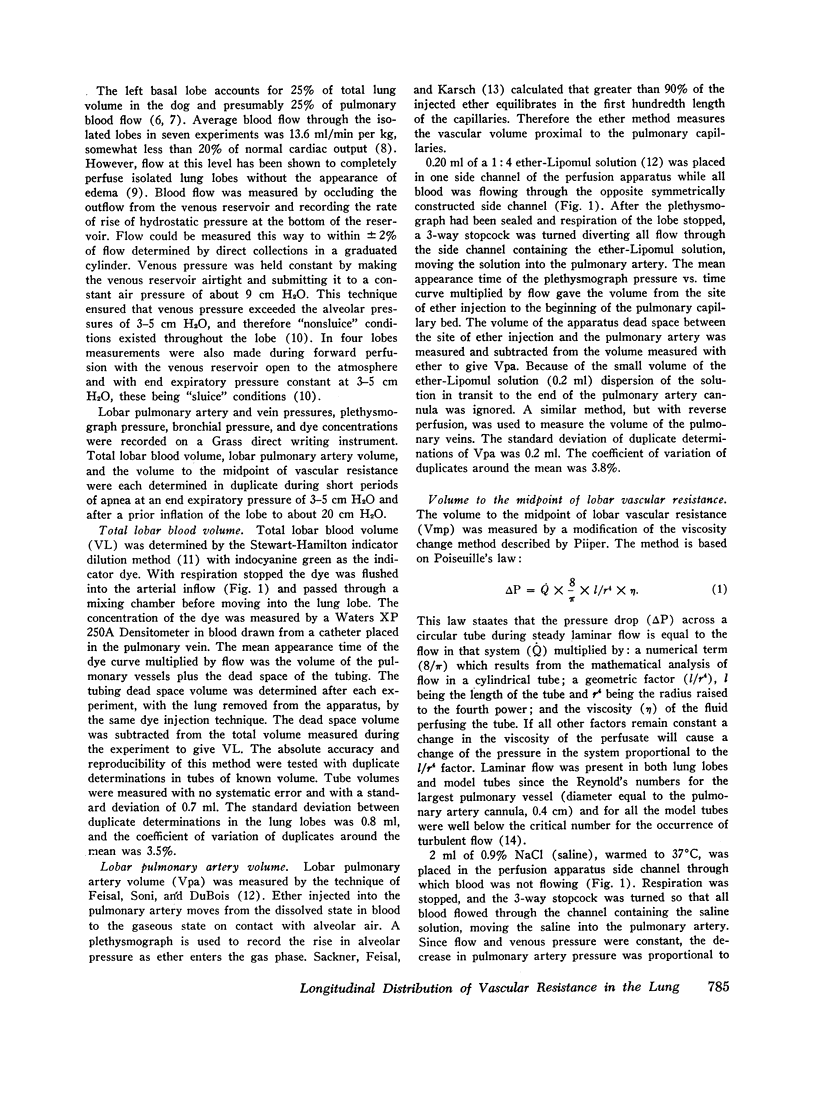

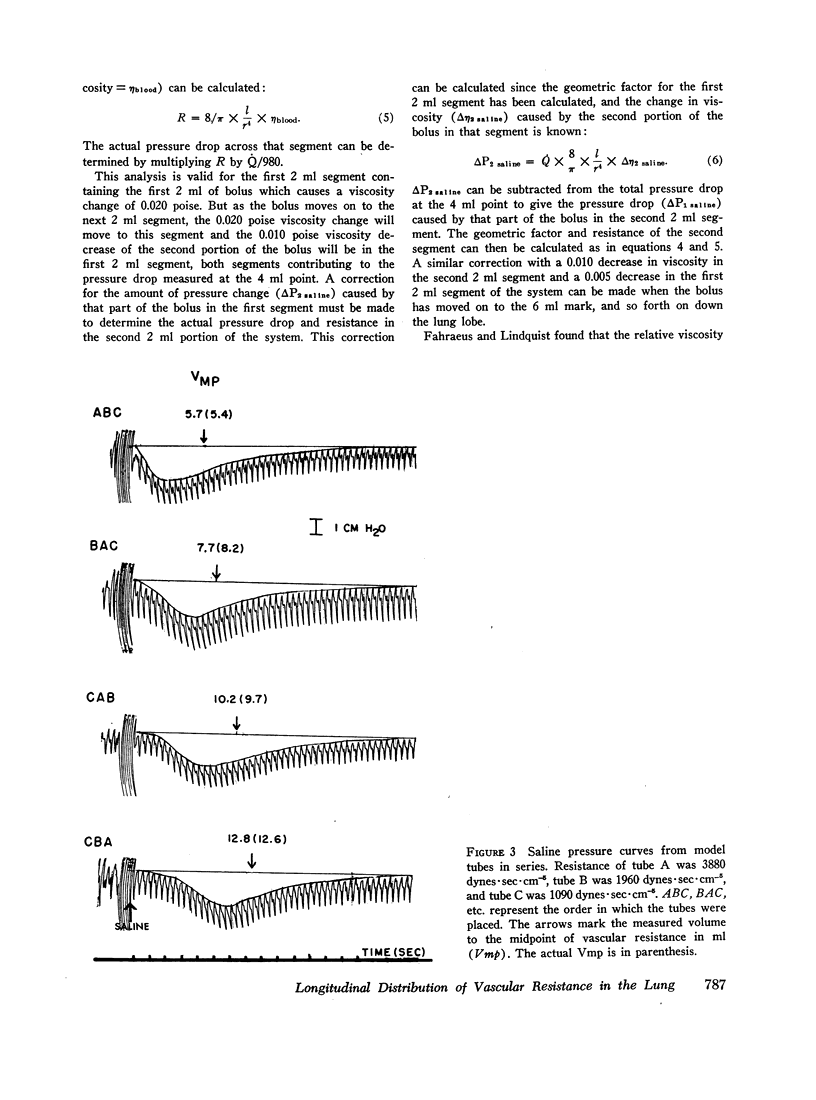
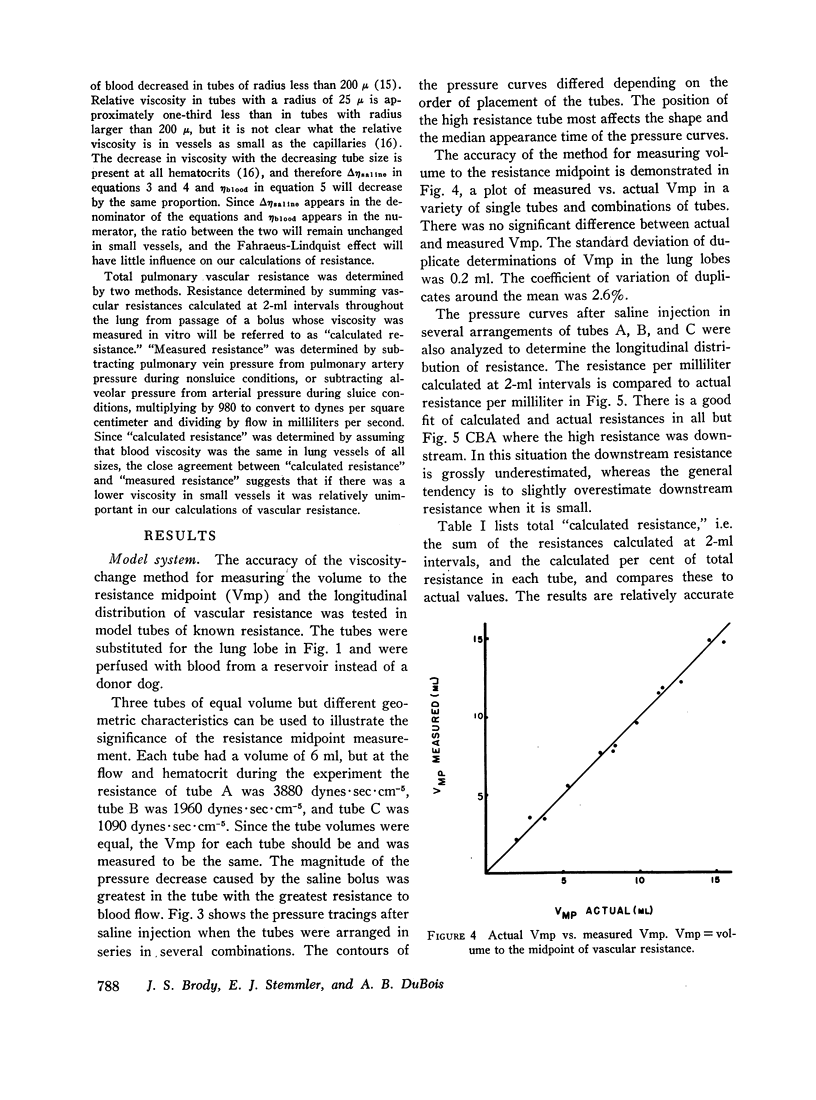
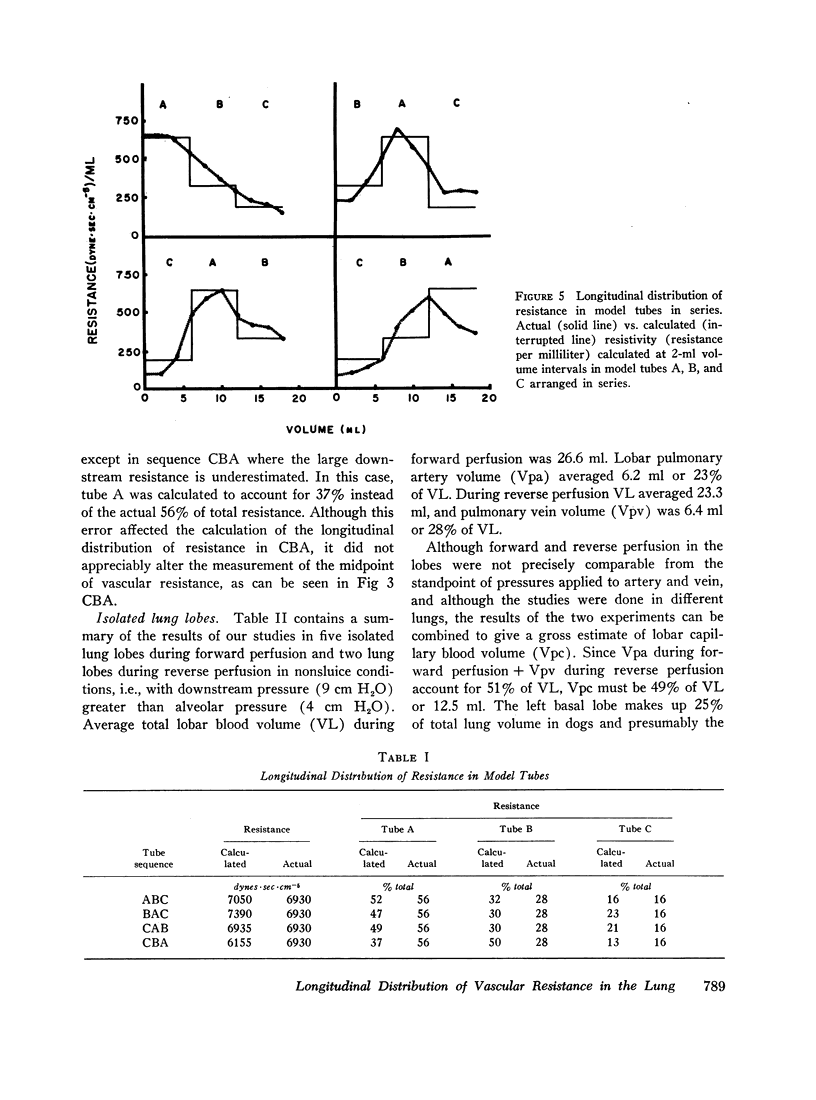

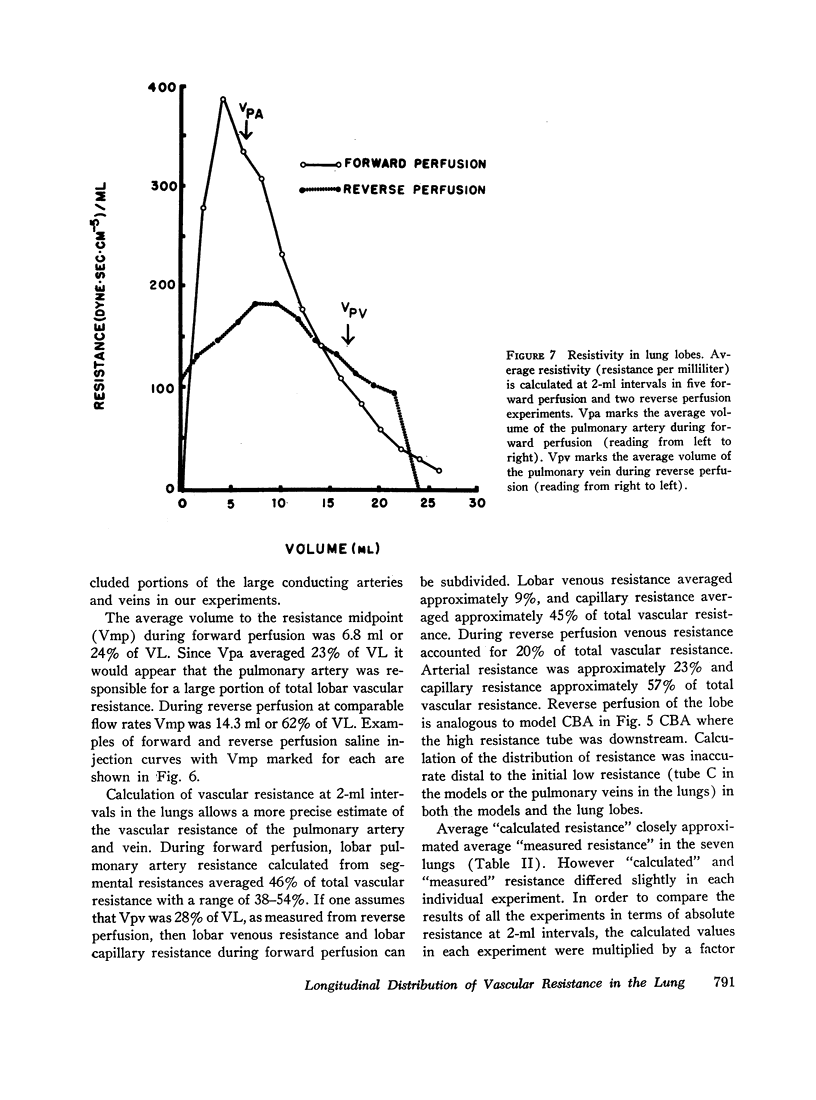

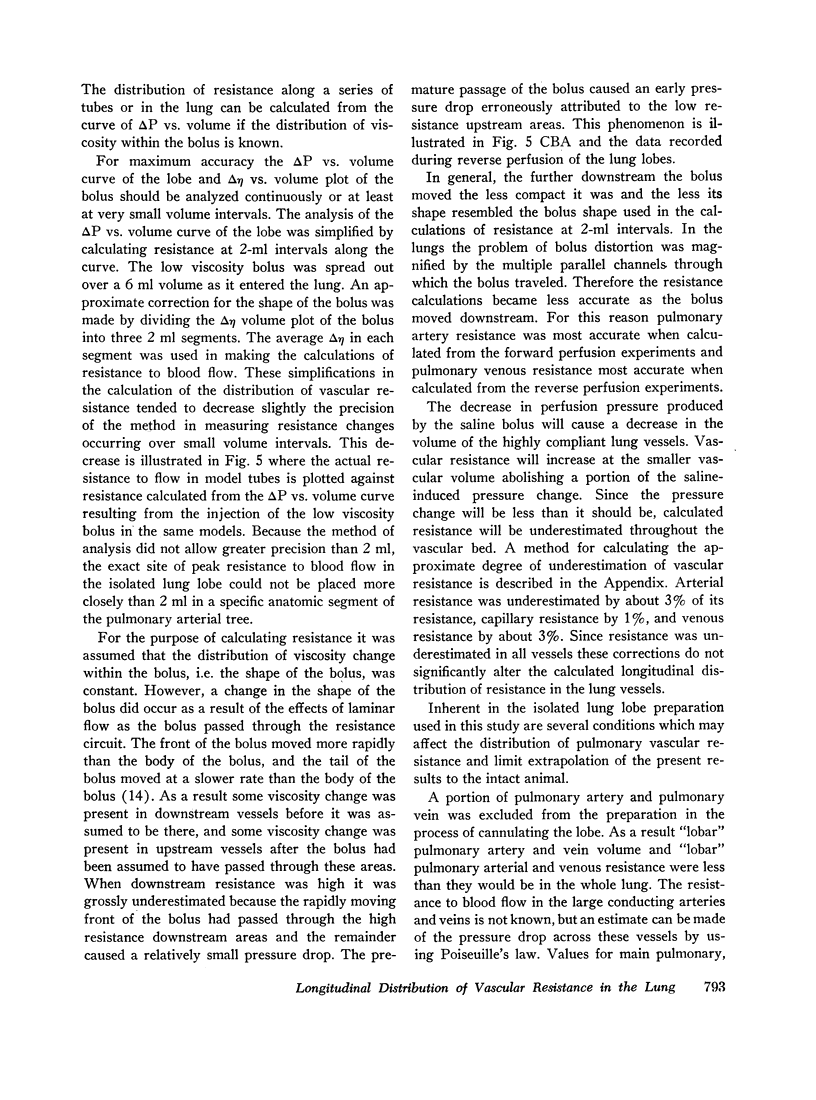
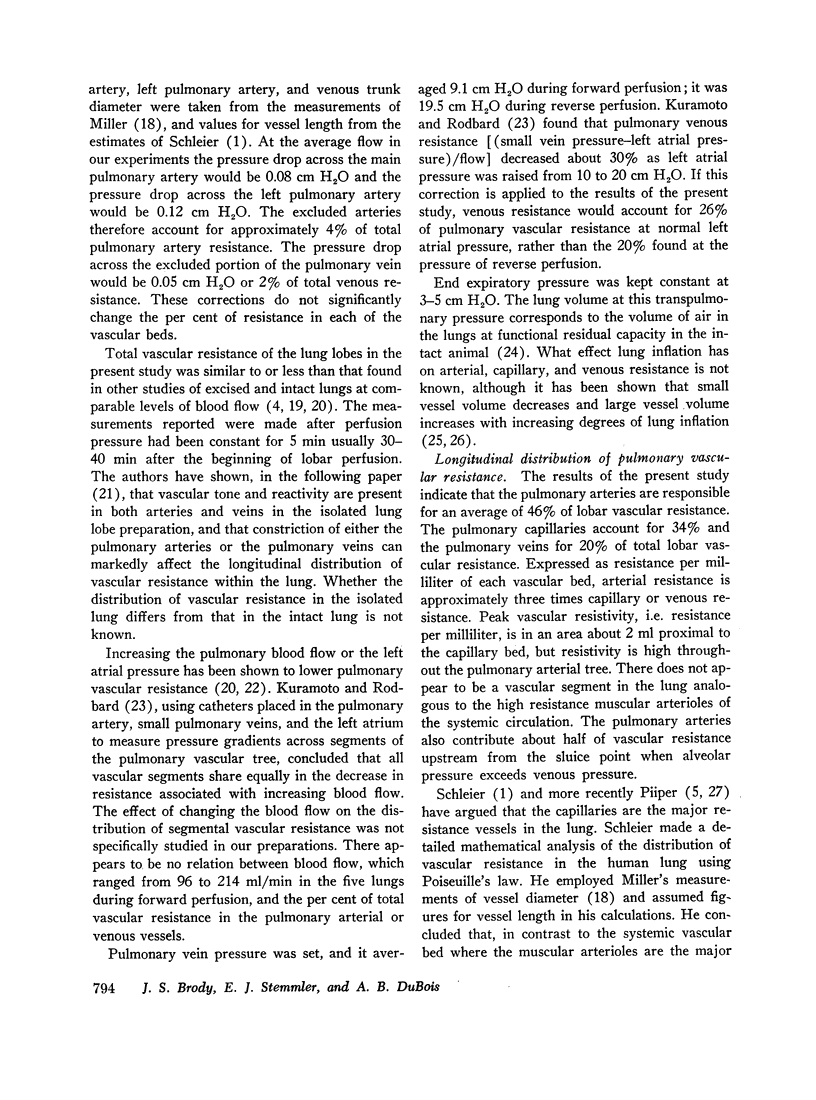
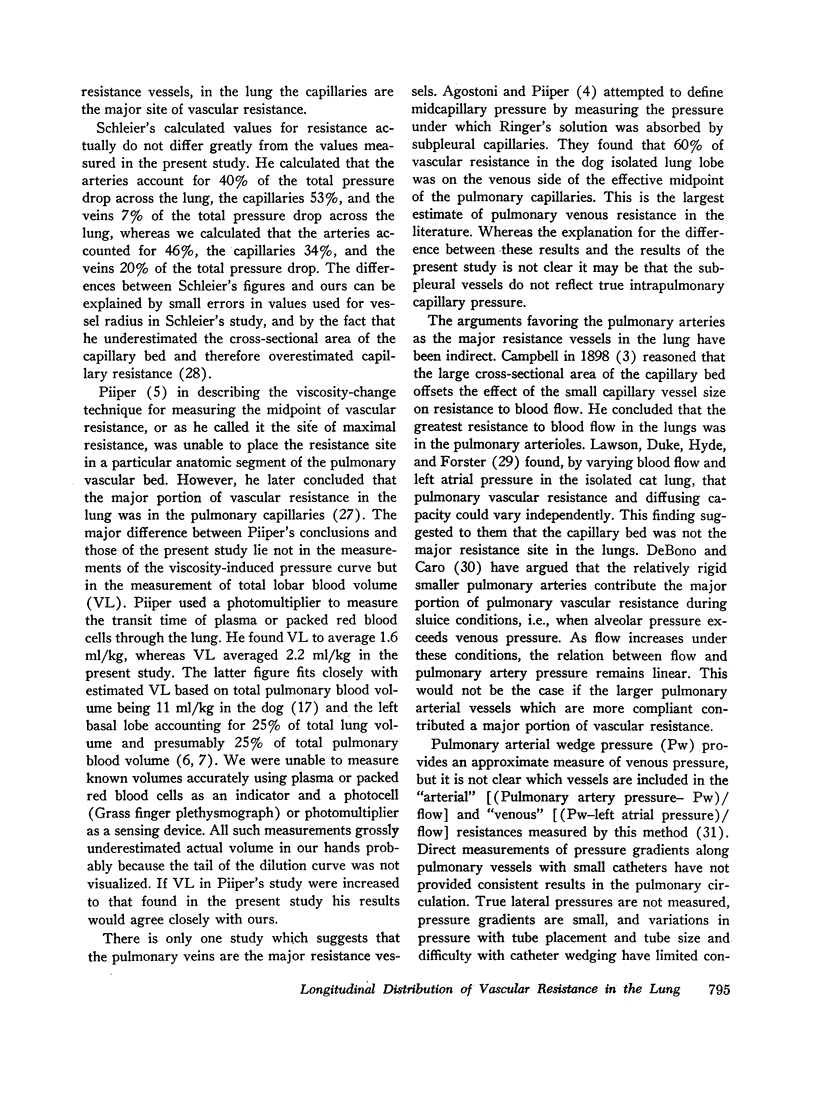


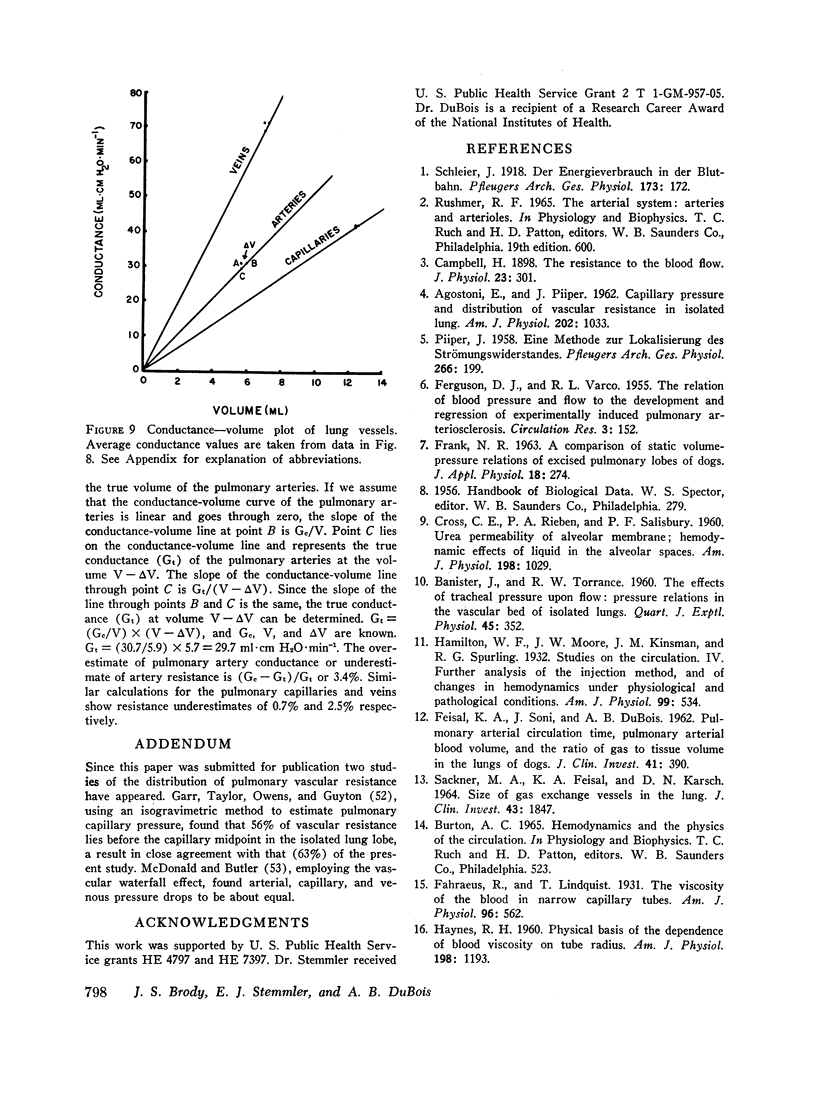
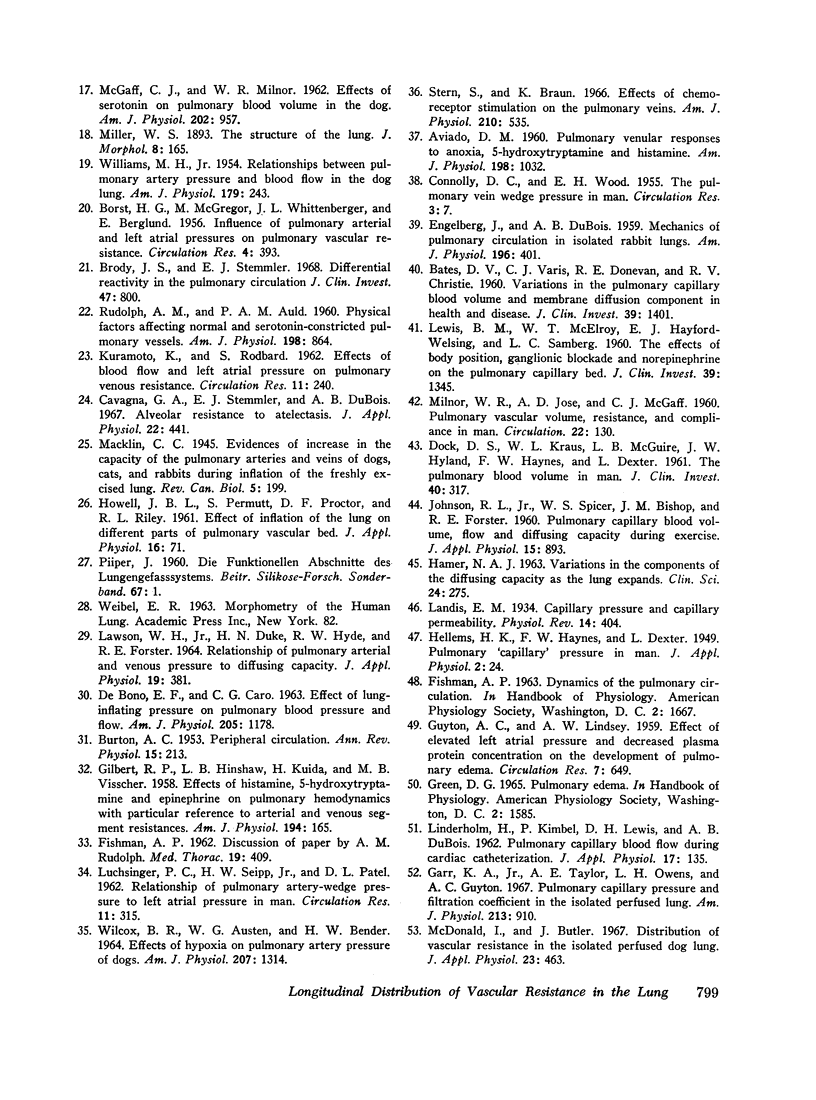
Selected References
These references are in PubMed. This may not be the complete list of references from this article.
- AGOSTONI E., PIPER J. Capillary pressure and distribution of vascular resistance in isolated lung. Am J Physiol. 1962 Jun;202:1033–1036. doi: 10.1152/ajplegacy.1962.202.6.1033. [DOI] [PubMed] [Google Scholar]
- AVIADO D. M. Pulmonary venular responses to anoxia, 5-hydroxytryptamine and histamine. Am J Physiol. 1960 May;198:1032–1036. doi: 10.1152/ajplegacy.1960.198.5.1032. [DOI] [PubMed] [Google Scholar]
- BANISTER J., TORRANCE R. W. The effects of the tracheal pressure upon flow: pressure relations in the vascular bed of isolated lungs. Q J Exp Physiol Cogn Med Sci. 1960 Oct;45:352–367. doi: 10.1113/expphysiol.1960.sp001491. [DOI] [PubMed] [Google Scholar]
- BATES D. V., VARVIS C. J., DONEVAN R. E., CHRISTIE R. V. Variations in the pulmonary capillary blood volume and membrane diffusion component in health and disease. J Clin Invest. 1960 Sep;39:1401–1412. doi: 10.1172/JCI104160. [DOI] [PMC free article] [PubMed] [Google Scholar]
- BORST H. G., MCGREGOR M., WHITTENBERGER J. L., BERGLUND E. Influence of pulmonary arterial and left atrial pressures on pulmonary vascular resistance. Circ Res. 1956 Jul;4(4):393–399. doi: 10.1161/01.res.4.4.393. [DOI] [PubMed] [Google Scholar]
- BURTON A. C. Peripheral circulation. Annu Rev Physiol. 1953;15:213–246. doi: 10.1146/annurev.ph.15.030153.001241. [DOI] [PubMed] [Google Scholar]
- Brody J. S., Stemmler E. J. Differential reactivity in the pulmonary circulation. J Clin Invest. 1968 Apr;47(4):800–808. doi: 10.1172/JCI105774. [DOI] [PMC free article] [PubMed] [Google Scholar]
- CONNOLLY D. C., WOOD E. H. The pulmonary vein wedge pressure in man. Circ Res. 1955 Jan;3(1):7–13. doi: 10.1161/01.res.3.1.7. [DOI] [PubMed] [Google Scholar]
- CROSS C. E., RIEBEN P. A., SALISBURY P. F. Urea permeability of alveolar membrane: hemodynamic effects of liquid in the alveolar spaces. Am J Physiol. 1960 May;198:1029–1031. doi: 10.1152/ajplegacy.1960.198.5.1029. [DOI] [PubMed] [Google Scholar]
- Campbell H. The Resistance to the Blood-flow. J Physiol. 1898 Nov 25;23(4):301–309. doi: 10.1113/jphysiol.1898.sp000729. [DOI] [PMC free article] [PubMed] [Google Scholar]
- Cavagna G. A., Stemmler E. J., DuBois A. B. Alveolar resistance to atelectasis. J Appl Physiol. 1967 Mar;22(3):441–452. doi: 10.1152/jappl.1967.22.3.441. [DOI] [PubMed] [Google Scholar]
- DEBONO E. F., CARO C. G. EFFECT OF LUNG-INFLATING PRESSURE ON PULMONARY BLOOD PRESSURE AND FLOW. Am J Physiol. 1963 Dec;205:1178–1186. doi: 10.1152/ajplegacy.1963.205.6.1178. [DOI] [PubMed] [Google Scholar]
- DOCK D. S., KRAUS W. L., McGUIRE L. B., HYLAND J. W., HAYNES F. W., DEXTER L. The pulmonary blood volume in man. J Clin Invest. 1961 Feb;40:317–328. doi: 10.1172/JCI104259. [DOI] [PMC free article] [PubMed] [Google Scholar]
- ENGELBERG J., DUBOIS A. B. Mechanics of pulmonary circulation in isolated rabbit lungs. Am J Physiol. 1959 Feb;196(2):401–414. doi: 10.1152/ajplegacy.1959.196.2.401. [DOI] [PubMed] [Google Scholar]
- FEISAL K. A., SONI J., DUBOIS A. B. Pulmonary arterial circulation time, pulmonary arterial blood volume, and the ratio of gas to tissue volume in the lungs of dogs. J Clin Invest. 1962 Feb;41:390–400. doi: 10.1172/JCI104493. [DOI] [PMC free article] [PubMed] [Google Scholar]
- FERGUSON D., VARCO R. L. The relation of blood pressure and flow to the development and regression of experimentally induced pulmonary arteriosclerosis. Circ Res. 1955 Mar;3(2):152–158. doi: 10.1161/01.res.3.2.152. [DOI] [PubMed] [Google Scholar]
- FRANK N. R. A comparison of static volume-pressure relations of excised pulmonary lobes of dogs. J Appl Physiol. 1963 Mar;18:274–278. doi: 10.1152/jappl.1963.18.2.274. [DOI] [PubMed] [Google Scholar]
- GILBERT R. P., HINSHAW L. B., KUIDA H., VISSCHER M. B. Effects of histamine, 5 hydroxytryptamine and epinephrine on pulmonary hemodynamics with particular reference to arterial and venous segment resistances. Am J Physiol. 1958 Jul;194(1):165–170. doi: 10.1152/ajplegacy.1958.194.1.165. [DOI] [PubMed] [Google Scholar]
- GUYTON A. C., LINDSEY A. W. Effect of elevated left atrial pressure and decreased plasma protein concentration on the development of pulmonary edema. Circ Res. 1959 Jul;7(4):649–657. doi: 10.1161/01.res.7.4.649. [DOI] [PubMed] [Google Scholar]
- Gaar K. A., Jr, Taylor A. E., Owens L. J., Guyton A. C. Pulmonary capillary pressure and filtration coefficient in the isolated perfused lung. Am J Physiol. 1967 Oct;213(4):910–914. doi: 10.1152/ajplegacy.1967.213.4.910. [DOI] [PubMed] [Google Scholar]
- HAMER N. A. Variations in the components of the diffusing capacity as the lung expands. Clin Sci. 1963 Apr;24:275–285. [PubMed] [Google Scholar]
- HAYNES R. H. Physical basis of the dependence of blood viscosity on tube radius. Am J Physiol. 1960 Jun;198:1193–1200. doi: 10.1152/ajplegacy.1960.198.6.1193. [DOI] [PubMed] [Google Scholar]
- HOWELL J. B., PERMUTT S., PROCTOR D. F., RILEY R. L. Effect of inflation of the lung on different parts of pulmonary vascular bed. J Appl Physiol. 1961 Jan;16:71–76. doi: 10.1152/jappl.1961.16.1.71. [DOI] [PubMed] [Google Scholar]
- JOHNSON R. L., Jr, SPICER W. S., BISHOP J. M., FORSTER R. E. Pulmonary capillary blood volume, flow and diffusing capacity during exercise. J Appl Physiol. 1960 Sep;15:893–902. doi: 10.1152/jappl.1960.15.5.893. [DOI] [PubMed] [Google Scholar]
- KURAMOTO K., RODBARD S. Effects of blood flow and left atrial pressure on pulmonary venous resistance. Circ Res. 1962 Aug;11:240–246. doi: 10.1161/01.res.11.2.240. [DOI] [PubMed] [Google Scholar]
- LAWSON W. H., Jr, DUKE H. N., HYDE R. W., FORSTER R. E. RELATIONSHIP OF PULMONARY ARTERIAL AND VENOUS PRESSURE TO DIFFUSING CAPACITY. J Appl Physiol. 1964 May;19:381–386. doi: 10.1152/jappl.1964.19.3.381. [DOI] [PubMed] [Google Scholar]
- LEWIS B. M., MCELROY W. T., HAYFORD-WELSING E. J., SAMBERG L. C. The effects of body position, ganglionic blockade and norepinephrine on the pulmonary capillary bed. J Clin Invest. 1960 Sep;39:1345–1352. doi: 10.1172/JCI104152. [DOI] [PMC free article] [PubMed] [Google Scholar]
- LINDERHOLM H., KIMBEL P., LEWIS D. H., DUBOIS A. B. Pulmonary capillary blood flow during cardiac catheterization. J Appl Physiol. 1962 Jan;17:135–141. doi: 10.1152/jappl.1962.17.1.135. [DOI] [PubMed] [Google Scholar]
- LUCHSINGER P. C., SEIPP H. W., Jr, PATEL D. J. Relationship of pulmonary artery-wedge pressure to left atrial pressure in man. Circ Res. 1962 Aug;11:315–318. doi: 10.1161/01.res.11.2.315. [DOI] [PubMed] [Google Scholar]
- MILNOR W. R., JOSE A. D., MCGAFF C. J. Pulmonary vascular volume, resistance, and compliance in man. Circulation. 1960 Jul;22:130–137. doi: 10.1161/01.cir.22.1.130. [DOI] [PubMed] [Google Scholar]
- McDonald I. G., Butler J. Distribution of vascular resistance in the isolated perfused dog lung. J Appl Physiol. 1967 Oct;23(4):463–474. doi: 10.1152/jappl.1967.23.4.463. [DOI] [PubMed] [Google Scholar]
- PIIPER J. Eine Methode zur Lokalisierung des Strömungswiderstandes. Pflugers Arch. 1958;266(2):199–206. doi: 10.1007/BF00363649. [DOI] [PubMed] [Google Scholar]
- RUDOLPH A. M., AULD P. A. Physical factors affecting normal and serotonin-constricted pulmonary vessels. Am J Physiol. 1960 Apr;198:864–872. doi: 10.1152/ajplegacy.1960.198.4.864. [DOI] [PubMed] [Google Scholar]
- SACKNER M. A., FEISAL K. A., KARSCH D. N. SIZE OF GAS EXCHANGE VESSELS IN THE LUNG. J Clin Invest. 1964 Sep;43:1847–1855. doi: 10.1172/JCI105058. [DOI] [PMC free article] [PubMed] [Google Scholar]
- Stern S., Braun K. Effect of chemoreceptor stimulation on the pulmonary veins. Am J Physiol. 1966 Mar;210(3):535–539. doi: 10.1152/ajplegacy.1966.210.3.535. [DOI] [PubMed] [Google Scholar]
- WILCOX B. R., AUSTEN W. G., BENDER H. W. EFFECT OF HYPOXIA ON PULMONARY ARTERY PRESSURE OF DOGS. Am J Physiol. 1964 Dec;207:1314–1318. doi: 10.1152/ajplegacy.1964.207.6.1314. [DOI] [PubMed] [Google Scholar]
- WILLIAMS M. H., Jr Relationships between pulmonary artery pressure and blood flow in the dog lung. Am J Physiol. 1954 Nov;179(2):243–245. doi: 10.1152/ajplegacy.1954.179.2.243. [DOI] [PubMed] [Google Scholar]


